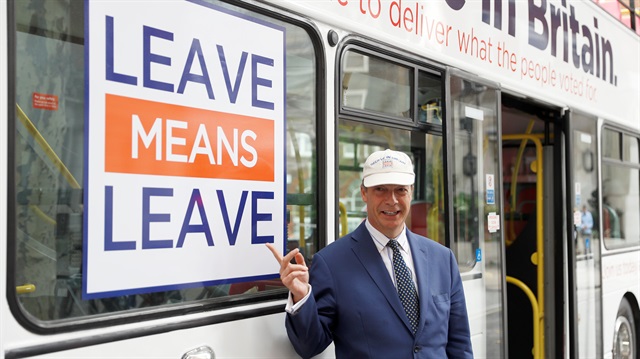

File photo: Nigel Farage poses for pictures as he launches Leave Means Leave's campaign against Britain's Prime Minister Theresa May's Chequers Brexit plan, in central London, Britain, September 20, 2018.
British Prime Minister Theresa May under pressure to secure a breakthrough
With just over six months left before the UK exits the European Union, uncertainty is high, with the terms of a new relationship between the two sides still being negotiated.
Talks between EU leaders and British Prime Minister Theresa May on reaching a deal have had their high and low points since the UK triggered divorce proceedings from the bloc in March 2017, but neither side has been completely satisfied with the progress made.
May, who is quite keen to strike a deal with EU leaders before the end of this year, has been accused of making too many concessions to European negotiators -- not only by those who voted to leave the union but also by some members of her cabinet, who are also unhappy with the latest British proposal dubbed Chequers, named after the prime minister's country retreat.
The Chequers plan caused an immediate stir in May’s cabinet and prompted two key officials to resign -- Foreign Secretary Boris Johnson and Brexit Secretary David Davis. In the House of Commons, meanwhile, the number of Tory MPs who are against the latest plan to adopt a common rulebook with the EU as part of Chequers is on the rise.
Salzburg summit
May’s Chequers plan hit a new low this week when it was openly rejected by EU officials and leaders of some member countries at an informal summit in Salzburg, Austria.
May told the summit the UK would not seek to delay Brexit or hold a second referendum and asked the EU to be more flexible in future talks over her plan, which she presented to the EU for the first time.
She underlined that Britain would not agree to any extension for negotiations and that a deal should be reached or the UK would leave the EU without one on March 29, 2019.
At a heated press conference, May said there is a “willingness for a deal", but “let nobody be in any doubt that we are preparing for no deal”.
Both the UK and the EU would like to see a deal signed before the end of the year, as it would leave probably just enough time for it to be ratified in the House of Commons and by the parliaments of the bloc’s 27 member countries before the exit date.
"We all recognize that time is short, but delaying or extending these negotiations is not an option,” May told EU leaders in Salzburg.
"I know that for many of you, Brexit is not something you want. But it's important to be clear: there will be no second referendum in the UK.
"The public has delivered its verdict, and I as prime minister will deliver upon that - the UK will leave on the 29th of March next year…I believe I have put forward serious and workable proposals. We will of course not agree on every detail, but hopefully you will respond in kind.
"The onus is now on all of us to get this deal done."
Irish Border
The border between the Republic of Ireland and Northern Ireland will become the only land border between the UK and EU after Brexit.
Since the 1998 Belfast Agreement, there has been an invisible border between the two sides.
But no one would like to see a hard border there with checkpoints and customs officers due to sensitivities in the region, and a solution that would work for the UK, the EU, Ireland and Northern Ireland – all of whom prefer the status quo – must be found.
May’s proposal under her Chequers plan is to adopt a common rulebook for goods and services and keep the standards within the UK the same with the EU’s so trade is not disturbed and it would not necessitate any checks on the border.
She has rejected a solution where checks could be done away from the border on both sides, saying it would still be a hard border.
Under pressure
Now that the Salzburg summit is over with no support for May’s Chequers plan, the negotiators are expected to work on a deal that is acceptable for both the UK and the EU.
At home, the already heavy pressure on May will continue to build as she defends the government’s Brexit White Paper at the Conservative Party Conference from Sept. 30-Oct. 3.
Surely her Brexit team will again look to the Chequers plan for solutions to sticking points. But it is unclear whether she can make more concessions to EU demands, especially their insistence that she accept a “backstop” plan that would come into play if all options fail but which many think would damage the UK’s integrity as it aims to keep Northern Ireland in the customs union under EU rules.
A Brexit deal could still be within reach with more flexibility from all sides, in what May described as ‘negotiation tactics’, and the next opportunity will be at the European Council Summit in October.
If progress can be made there, the EU will call an emergency Brexit summit in November. Otherwise, there will be a "no deal" scenario at the end of next March.
#border
#Brexit
#Chequers
#EU
#Ireland
#MPs
#plan
#Theresa May
#UK






